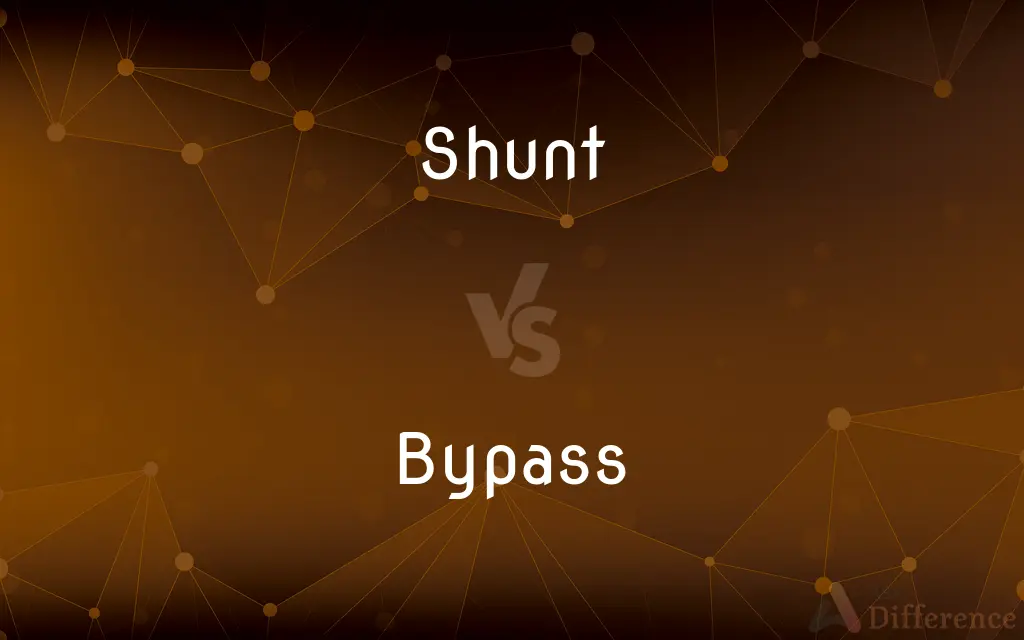Shunt vs. Bypass — What's the Difference?
By Maham Liaqat & Urooj Arif — Updated on April 24, 2024
A shunt redirects flow internally within a system or organ, emphasizing redirection of existing pathways; a bypass creates an alternate route, often to avoid an obstacle or damage.

Difference Between Shunt and Bypass
Table of Contents
ADVERTISEMENT
Key Differences
A shunt is primarily used to refer to a device or pathway that diverts flow from one part of a system to another, often within the same network. It's commonly used in medical and electrical contexts. On the other hand, a bypass refers to an alternate route, typically constructed to detour around something rather than through it, used extensively in medical, computing, and transportation contexts.
In electrical engineering, a shunt is a low-resistance connection that allows an electric current to pass around another point in the circuit. Conversely, a bypass in electronics might involve a capacitor or other component that provides an alternative path for certain frequency signals to avoid interference.
In computing, shunting can refer to the rerouting of network traffic or signals within a circuit or between processors to enhance performance or manage loads. Whereas, bypassing in computing usually involves ignoring certain standard operations or checkpoints in software to streamline processes or during troubleshooting.
In transportation, a shunt often implies the controlled movement of train cars within a railyard, while a bypass is a road built to avoid city congestion, improving traffic flow by allowing drivers to circumvent city streets.
Comparison Chart
Definition
Diversion within an existing pathway or system
Creation of an alternate route around an obstacle
ADVERTISEMENT
Common Uses
Medical (fluid diversion), Electrical (current diversion)
Medical (arterial surgery), Transport (alternative roads)
Purpose
To manage or correct flow in existing pathways
To avoid problems or obstructions in the usual path
Method
Redirecting internally
Constructing an external detour
Compare with Definitions
Shunt
A channel or passage that redirects part of a flow from one pathway to another.
The doctor recommended installing a shunt to relieve the hydrocephalus.
Bypass
An alternative route that is usually longer but potentially less problematic.
During the road works, all trucks were required to take the bypass route.
Shunt
A device or procedure in medicine to divert fluid in the body to prevent or reduce problematic accumulations.
The neurosurgeon placed a shunt in the patient’s brain to drain excess cerebrospinal fluid.
Bypass
A medical procedure to create an alternative channel for the flow of bodily fluids or substances.
The coronary bypass has significantly improved his quality of life.
Shunt
An electrical device that allows current to pass around another point in the circuit.
The engineer used a shunt resistor to measure the current through the main circuit without interrupting it.
Bypass
To avoid using a standard procedure or system, often to save time or resources.
She bypassed the usual processing steps to expedite the client’s request.
Shunt
To redirect or divert resources, information, or attention to an alternative path.
The IT department shunted the network traffic to a secondary line during the system upgrade.
Bypass
A road built around a town or congested area to ease traffic flow.
The new bypass will help commuters avoid the downtown traffic jams.
Shunt
A method in railways for moving a train or train cars from one track to another within a railyard.
The yardmaster orchestrated the shunt of freight cars to prepare for the morning shipment.
Bypass
A method in computing and electronics to avoid interference or improve efficiency by creating an alternate pathway for signals or data.
To manage the overheating, the system’s safety features were bypassed temporarily.
Shunt
Provide with or divert by means of an electrical shunt
Bypass
A highway or section of a highway that passes around an obstructed or congested area.
Shunt
The act or process of turning aside or moving to an alternate course.
Bypass
A pipe or channel used to conduct gas or liquid around another pipe or a fixture.
Shunt
A railroad switch.
Bypass
A means of circumvention.
Shunt
(Electricity) A low-resistance connection between two points in an electric circuit that forms an alternative path for a portion of the current. Also called bypass.
Bypass
(Electricity)See shunt.
Shunt
To turn or move aside or onto another course
Shunting traffic around an accident.
Bypass
A surgical procedure to create such a channel
A coronary artery bypass.
A gastric bypass.
Shunt
To evade by putting aside or ignoring
Urgent problems that society can no longer shunt aside.
Bypass
To avoid (an obstacle) by using an alternative channel, passage, or route.
Shunt
To switch (a train or car) from one track to another.
Bypass
To be heedless of; ignore
Bypassed standard office procedures.
Shunt
(Electricity) To provide or divert (current) by means of a shunt.
Bypass
To channel (piped liquid, for example) through a bypass.
Shunt
(Medicine) To divert or permit flow of (a body fluid) from one pathway or region to another by surgical means.
Bypass
A road that passes around something, such as a residential area or business district.
Shunt
To move or turn aside.
Bypass
The act of going past or around.
Shunt
(Electricity) To become diverted by means of a shunt. Used of a circuit.
Bypass
A section of pipe that conducts a fluid around some other fixture.
Shunt
(transitive) To cause to move (suddenly), as by pushing or shoving; to give a (sudden) start to.
Bypass
An electrical shunt.
Shunt
(transitive) To divert to a less important place, position, or state.
Bypass
(medicine) An alternative passage created to divert a bodily fluid around a damaged organ; the surgical procedure to construct such a bypass.
Shunt
(transitive) To provide with a shunt.
To shunt a galvanometer
Bypass
To avoid an obstacle etc, by constructing or using a bypass.
Shunt
To move data in memory to a physical disk.
Bypass
To ignore the usual channels or procedures.
Shunt
To divert electric current by providing an alternative path.
Bypass
A road that takes traffic around the edge of a town
Shunt
To move a train from one track to another, or to move carriages, etc. from one train to another.
Bypass
A surgically created shunt (usually around a damaged part)
Shunt
To have a minor collision, especially in a motor car.
Bypass
A conductor having low resistance in parallel with another device to divert a fraction of the current
Shunt
To divert the flow of a body fluid.
Bypass
Avoid something unpleasant or laborious;
You cannot bypass these rules!
Shunt
To turn aside or away; to divert.
Shunt
To carry on arbitrage between the London stock exchange and provincial stock exchanges.
Shunt
An act of moving (suddenly), as due to a push or shove.
Shunt
(electricity) A connection used as an alternative path between parts of an electrical circuit.
Shunt
(firearms) The shifting of the studs on a projectile from the deep to the shallow sides of the grooves in its discharge from a shunt gun.
Shunt
An abnormal passage between body channels.
Shunt
(surgery) A passage between body channels constructed surgically as a bypass; a tube inserted into the body to create such a passage.
Shunt
(rail transport) A switch on a railway used to move a train from one track to another.
Shunt
A minor collision between vehicles.
Shunt
To shun; to move from.
Shunt
To cause to move suddenly; to give a sudden start to; to shove.
Shunt
To turn off to one side; especially, to turn off, as a grain or a car upon a side track; to switch off; to shift.
For shunting your late partner on to me.
Shunt
To provide with a shunt; as, to shunt a galvanometer.
Shunt
To go aside; to turn off.
Shunt
A turning off to a side or short track, that the principal track may be left free.
Shunt
A conducting circuit joining two points in a conductor, or the terminals of a galvanometer or dynamo, so as to form a parallel or derived circuit through which a portion of the current may pass, for the purpose of regulating the amount passing in the main circuit.
Shunt
The shifting of the studs on a projectile from the deep to the shallow sides of the grooves in its discharge from a shunt gun.
Shunt
A conductor having low resistance in parallel with another device to divert a fraction of the current
Shunt
Implant consisting of a tube made of plastic or rubber; for draining fluids within the body
Shunt
Transfer to another track, of trains
Common Curiosities
How does an electrical shunt work?
An electrical shunt works by providing a low-resistance path for electric current to pass through, which is used for measuring current or diverting it to protect other components.
What are the typical materials used in making shunts in medical applications?
Medical shunts are often made from biocompatible materials like silicone or polyurethane, which are safe for long-term implantation in the body.
How is a bypass road constructed?
A bypass road is constructed by creating a new roadway that diverts traffic around a city or congested area, involving extensive planning, land acquisition, and environmental considerations.
What risks are associated with installing a shunt?
Risks of installing a shunt include infection, blockage, malfunction of the shunt, and in some cases, the need for revision surgery.
Can a shunt be temporary?
Yes, some shunts, especially in medical procedures, can be designed to be temporary, used to relieve symptoms or conditions until a more permanent solution is applied or the underlying issue resolves.
How do shunts affect system efficiency?
Shunts can increase system efficiency by allowing precise control over flow and distribution in both medical and technical applications, though they may also introduce complexity.
What environmental impacts does constructing a new bypass have?
Constructing a new bypass can have significant environmental impacts, including habitat disruption, changes in local ecosystems, and increased pollution during construction.
What maintenance is required for a shunt?
Maintenance for a medical shunt may include regular monitoring for functionality and blockages, adjustments, and potentially replacement if the shunt fails or is outgrown, particularly in pediatric patients.
What are the economic implications of building a bypass?
Building a bypass can have substantial economic implications, including the initial cost of construction, potential displacement of residents, and long-term benefits like improved traffic flow and economic development in less congested areas.
What are the benefits of using a bypass in a computer network?
Using a bypass in a computer network can help avoid overloaded servers, reduce latency, and enhance the overall efficiency and reliability of network communication.
How can a bypass improve emergency response times?
A bypass can improve emergency response times by reducing traffic congestion and providing a more direct route for emergency vehicles, thus speeding up response times to critical situations.
How does a bypass differ from a detour?
A bypass is a permanent route constructed to reroute traffic from the usual path, mainly to reduce congestion, while a detour is a temporary route used during road closures or obstructions.
What is the difference between a shunt and a bypass in hydraulic systems?
In hydraulic systems, a shunt is used to divide flow between different branches of the system, while a bypass is used to create an alternate route, typically to allow maintenance or manage high pressure without stopping the system.
What are the signs that a shunt might be malfunctioning?
Signs of a malfunctioning shunt include symptoms of the original medical condition worsening, such as increased pressure, headaches, and vision problems in the case of cerebral shunts.
Share Your Discovery

Previous Comparison
Coursebook vs. Textbook
Next Comparison
Shelf vs. ShelveAuthor Spotlight
Written by
Maham LiaqatCo-written by
Urooj ArifUrooj is a skilled content writer at Ask Difference, known for her exceptional ability to simplify complex topics into engaging and informative content. With a passion for research and a flair for clear, concise writing, she consistently delivers articles that resonate with our diverse audience.
















































